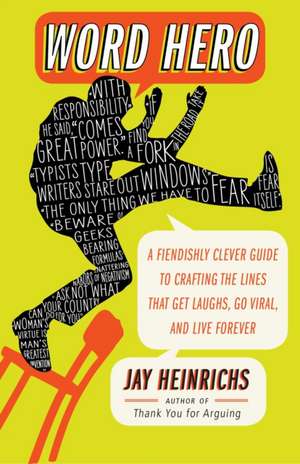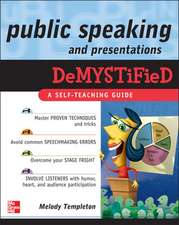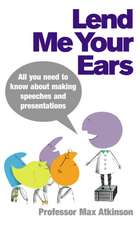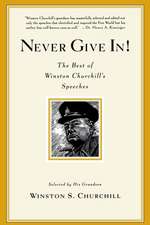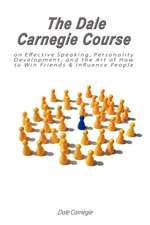Word Hero: A Fiendishly Clever Guide to Crafting the Lines That Get Laughs, Go Viral, and Live Forever
Autor Jay Heinrichsen Limba Engleză Paperback – 30 sep 2011
Ever hear someone utter an unforgettable phrase and feel yourself reacting with with…well, awe? Ever read a great quote and think I could never come up with anything that clever?
Daunting as it may seem, there’s nothing mystical about witcraft. Crafting memorable lines doesn’t require DNA-encoded brilliance. What it does require is some knowledge of the tricks and techniques that make words stick.
In Word Hero, Jay Heinrichs rescues the how-to of verbal artistry from cobwebbed textbooks and makes it entirely fresh ߝ even a little mischievous. Fear not: on offer here are not dry, abstract ideas couched in academic jargon. Rather, Heinrichs takes you on an amusing ߝ and amazingly helpful ߝ tour of the mechanisms that make powerful language work. You’ll learn how to slyly plant your words in people’s heads and draw indelible verbal pictures by employing such tools as “crashing symbols,” “rapid repeaters,” “Russian Dolls” and even the powers of Mr. Potato Head.
With those tools and others tucked in your utility belt, you might not immediately achieve “wordsmith immortality” but you will become a better speaker, writer, and raconteur…and long after people have forgotten everything else, they’ll remember your priceless lines.
Preț: 114.60 lei
Nou
Puncte Express: 172
Preț estimativ în valută:
21.93€ • 22.90$ • 18.15£
21.93€ • 22.90$ • 18.15£
Carte disponibilă
Livrare economică 15-29 martie
Preluare comenzi: 021 569.72.76
Specificații
ISBN-13: 9780307716361
ISBN-10: 0307716368
Pagini: 352
Dimensiuni: 130 x 201 x 20 mm
Greutate: 0.3 kg
Ediția:New.
Editura: Three Rivers Press (CA)
ISBN-10: 0307716368
Pagini: 352
Dimensiuni: 130 x 201 x 20 mm
Greutate: 0.3 kg
Ediția:New.
Editura: Three Rivers Press (CA)
Notă biografică
JAY HEINRICHS has spent more than 25 years in publishing as a magazine writer, editor, and executive. His previous book on language, Thank You for Arguing, has sold more than 100,000 copies.
Extras
1
PRACTICE WITCRAFT
The Square Root of Rainbows Formulas for Memorability
My first real lesson in what I call “witcraft” came off a loading dock in Philadelphia. I was sixteen and just starting my first summer job at a department store. My assigned mentor, Al, was a man of the world at least two years my senior. He led me onto a semitrailer and pulled a thousand-dollar dress from a hanging rack.
“Observe.”
Al ripped the fabric down the middle, recorded the dress as damaged, and turned significantly to me. “With responsibility,” he said, “comes great power.”
I had heard the old chestnut about power and responsibility, but it had never occurred to me that a cliche could be corrupted so deliciously. From that day on, I hung on to everything the guy said.
In retrospect, he wasn’t all that witty, and his bon mot certainly wasn’t worth a designer gown. Needless to say, Al proved to be a dubious moral guide; next day he taught me how to surf the roof of a moving delivery van. But that summer he became my first living Word Hero.
In the years since, I’ve studied witcraft as an effective way to change people’s emotions, their minds, and their willingness to act. I learned how to get people’s attention and make a good impression, even better than the one Al made on me. I wrote a book, Thank You for Arguing, and went on to coach rhetoric, the art of persuasion, with students, lawyers, corporate execs, and aerospace engineers. I read all the ancient and modern rhetorical wisdom I could find and have employed the advice and help of hundreds of experts.
But Al was the first to teach me the essence of word heroism: with a very little wit comes great power.
THE SHAPE AND FORM OF HEROISM
Since then I’ve had some terrific mentors. The great Roman orator Marcus Tullius Cicero--lowborn, stubby, turnip-nosed Cicero--stood on words and led the Roman republic. He and other rhetoricians through history, from Joan of Arc to Barack Obama, grasped the secrets of image crafting through witcraft. They set their words in stone, sometimes literally. They were Word Heroes. I’d like to help make you, too, into a Word Hero; maybe not on the order of a Shakespeare or Churchill, but someone who holds a share of immortality.
Word heroism takes very few words--no more than a dozen or so. Few of us remember Franklin Roosevelt’s speeches, but many of us remember the memorable, the characteristic parts, that made FDR FDR. “The only thing we have to fear is fear itself.” “This is a day that will live in infamy.”
To create memorable words yourself, you simply need to discover a set of techniques,--forty-three in all--that have been used by masters from Winston Churchill to Jimmy Kimmel. These tools will help you focus on the few words that count the most in a conversation, argument, important e‑mail, blog post, thank-you letter, college paper, or presentation.
This book does far more than merely list the techniques, though. Consider it a course in self-taught heroism, and use it to develop your own unforgettability. From the next chapter on, you will progress through the stages of phrase-making mastery, beginning with Word Apprentice and working up to Word Hero, that rarified state where your witcraft compels people to remember your name. By the time you achieve word heroism, you will have gained:
* Confidence in your ability to write and speak
* Knowledge of what makes a memorable expression memorable
* Prowess in producing the right words in just the right order for maximum effect
* Skill in the techniques used (consciously or instinctively) by the most unforgettable personalities in history and pop culture
You’ll project a strong, articulate personality, the kind people like and respect. But we’re talking about more than image polishing. We’re talking about a lasting image, one that lingers after you leave the room--or this mortal coil, for that matter. The right words, arranged perfectly, leave a lasting impression in an audience’s brain. And what are the techniques to create this magic? Figures of speech.
Word sounds and rhythms, puns and wordplay qualify as figures--the term rhetoricians give words in unusual context or order.
You know the expression “That’s just a figure of speech.” Personally, I object to the “just.” Figures can do for speech what architectural forms do for a cityscape, or the female human form does to your average randy male. A figure in the physical world composes the shape or form of something; look at the Washington Monument on a foggy day and you’ll make out the figure of a column. Less monumentally, we traditionally call a woman’s shape or form her figure. A figure of speech works the same way, usually without the obsession over phallic architecture and weight loss. This rhetorical figure constitutes the shape or form of words in a sentence.
Figures get an audience’s attention because they stand out from the rest of language. Take this head-snapping hyperbole from the TV show Glee:
Sue: You have enough product in your hair to season a wok.
An unexpected ending to an ordinary line (again, in Glee) can get an audience’s attention.
Kurt: He’s cheating off a girl who thinks the square root of four is rainbows.
You can raise eyebrows by ironically agreeing with your interlocutor.
Will: Who’s to say everything I do is one hundred percent on the ball?
Sue: No one would say that.
It’s all about delivering the unexpected. The audience unconsciously hyperfocuses on your words and makes its own links to the familiar. The effort makes them more than passive listeners. They become active participants in your words. (If you’re witty enough, you hear this participation in the form of laughter.) The links the brain makes between the familiar and the less familiar take place in electrochemical connections called synapses. Imagine if you ran into Angelina Jolie on an elevator. Even if you had never met her before, your brain has linked up enough synapses that you would have no trouble recognizing her. Stranger who doesn’t know me, the brain says, while the synapses fire like crazy: Movies. Dark-haired women. Fat lips. Hollywood beauties. Eighty-seven adopted kids. Brangelina. And so on. What got your attention in the first place was the shock of seeing this familiar-looking woman. Your brain did the rest. Memorability comes in part from linking the familiar (Angelina!) with the unfamiliar (Hollywood star in my elevator!). The utterly familiar, on the other hand (same creepy guy you see every day, inspection sticker), gets ignored.
You know how camouflage works, using patterns and colors to fade into the background. Similarly, a good spy looks perfectly ordinary and speaks in perfectly ordinary ways. To rouse someone’s awareness, you do the opposite: go for the unusual and unexpected. Later on, you’ll see figures that help you sneak up on an audience and give it a rhetorical knock on the head. The more surprising figures mug the audience’s expectations, twist grammar or logic, or marry unlike things. You can use them to look witty, tell a memorable story, get a laugh, or change the emotions in the room. But all figures deliver something out of the ordinary. Every good figure is an attention-getting figure.
I selected the best figures for the tools in this book. The easiest and most fun part of rhetoric, figures compose the core of my language blog, Figarospeech.com, where I take on the guise of Figaro (last name “Speech”), a committed, even obsessive, “figurist,” or coiner of figures. Figaro explores the tricks and pratfalls of language in politics and the media. Owing to our national ignorance of rhetoric, I tend to find more pratfalls than tricks. But knowing your figures can turn you from someone of the pratfall variety into a skilled practitioner of the art. With the right tools, you will gain the ability to compose beautiful prose, express irrefutable anger, proclaim your love, get people on your side, or thank them as they have never been thanked.
Figures can do all that. The Greeks believed in them so much that the philosopher Plato actually wanted to ban them. If Plato had had his way, Athens might have had a figure czar just as we have a drug czar. He had a point. Figures in the wrong hands can be powerful forces for evil as well as for good. In fact, your ability to spot their use will let you see through the tricks of marketers and politicians.
In your own hands, well, make sure you act the hero.
A warning: too much of this good thing--this witcraft and clever wording--can become an embarrassment of riches, overwhelming your audience or turning it off. Not even Churchill and MLK came up with a blockbuster in every sentence. Their audiences’ heads would have exploded. Use the tools in the book for a few great memorable words, and then build your other, simpler words around them.
WORD IT LIKE WARREN
In fact, born Word Heroes use figures instinctively without sounding overly ornate. Take Warren Buffett. Investors read his annual Berkshire Hathaway chairman’s letter as if it came from the oracle of Delphi. They savor his wit while they glean the secrets of the world’s savviest investor. OK, they read mostly for the investment secrets; but how many investment letters get quoted for decades afterward? Warren Buffett’s do, because he proves himself to be a wizard at figures, the rhetorical as well as the business kind.
For instance, Buffett clearly likes one of my own favorite devices: taking cliches literally. Look at this quote from a panel discussion he did in 2008:
Buffett: I try to buy stock in businesses that are so wonderful that an idiot can run them. Because sooner or later, one will.
See what he did? He took the cliche “an idiot can run it” and imagined it wasn’t a cliche at all. Why prefer something that an idiot can run, if an idiot will never run it?
Buffett even instinctively knows the figure that defines terms to get the upper hand in an argument.
Buffett: Price is what you pay. Value is what you get.
The quote reminds me of the late, lamented cartoon “Shoe.” In one strip the son asks his journalist dad, “Why are you staring out the window? You should be typing.” Dad answers, “Typists type. Writers stare out windows.” This device, which chapter 8 covers, lets you redefine an issue in one short expression.
If you really want to achieve immortality, though, talk like Yogi Berra, the immortal logic buster who said, “If you find a fork in the road, take it,” and “Nobody goes there anymore. It’s too crowded.” When you abandon logic to achieve a higher wisdom, you coin a figure called a Yogism (chapter 12). Warren Buffett is good at this, too.
Buffett: Occasionally, a man must rise above principles.
You have to love a wit like that--and people do. Easy for Warren to say, right? Well, speaking figuratively does take practice. It also takes a bit of studying. I make the studying part easier with a method for examining memorable words. Called unwriting, it works like this: to see how a quote you like varies from plain ordinary speech, write it as you or I would normally say it, without the wit. You’ll learn this technique in chapter 3.
To get the general idea of unwriting, grab this Buffett quote:
Buffett: Beware of geeks bearing formulas.
Next, put it in plain, unmemorable language:
Unwritten: You should be skeptical of number crunchers and their computer models.
Now ask yourself how Buffett’s quote varies from the unwritten version. As he often does, he twisted a cliche--“Beware of Greeks bearing gifts.” The old saying probably occurred to him when he was thinking of computer geeks. Hmmm. Beware of geeks . . . Beware of geeks bearing . . . um, formulas! All you have to do to complete the picture is to become an investment wizard and make more money than anybody in the world. Personally, I still find mutual funds a mystery. But you have to start somewhere. Besides, while Word Heroes like Buffett are to the mannerisms born, the rest of us must be made. We have to learn the tools.
NAMING THE TOOLS
In ancient Rome, students learned their figures after they learned grammar, considering them to be the next step in training the sophisticated mind. While schools still teach some grammar, modern education tends to stop at that point. It’s as if our education ground to a halt in the sixth grade, as if our society limited mathematics to arithmetic and ignored the calculus and finite math behind our bridges and computers. An education in figurative language actually helps you move beyond grammar. Some people--the kind who see grammar as the equivalent of the laws of Moses--need to get used to some figures. Logic lovers may not like the more fallacious aspects of figures either. But as you shall see, there are good, persuasive reasons to bend the rules.
The same urge that drives some of us to know the rules also makes us want to learn the names for the tools. It certainly helps to know the difference between an adjective and an adverb, and a pronoun’s missing antecedent can be difficult to spot when you don’t know your antecedent from your elbow. For similar reasons, you will find names for the figurative tools in this book, in the chapters that describe them as well as in an appended glossary. Not only can the terms help you remember the techniques themselves, but they also help prove that I have some serious scholarly backup--that the figures did not spring newborn out of my head.
The problem is, most of the official terms for these techniques happen to come in the form of unpronounceable ancient Greek. Take, for instance, this old joke:
You said you wanted to play football in the worst way. Well, you’re playing it in the worst way.
The joke uses a remarkably useful device that repeats words while changing their meaning. The figure has an official name, antistasis (an-TIH-sta-sis), but in the text I call it the repeat changer. If you once happened to be the kind of curious child who memorized the names of dinosaurs, rest assured that you will find the official name wherever one exists. For those of us who find the tools more important than the names, my informal labels should make the tools easier to remember. After all, it’s what the tools do that counts.
PRACTICE WITCRAFT
The Square Root of Rainbows Formulas for Memorability
My first real lesson in what I call “witcraft” came off a loading dock in Philadelphia. I was sixteen and just starting my first summer job at a department store. My assigned mentor, Al, was a man of the world at least two years my senior. He led me onto a semitrailer and pulled a thousand-dollar dress from a hanging rack.
“Observe.”
Al ripped the fabric down the middle, recorded the dress as damaged, and turned significantly to me. “With responsibility,” he said, “comes great power.”
I had heard the old chestnut about power and responsibility, but it had never occurred to me that a cliche could be corrupted so deliciously. From that day on, I hung on to everything the guy said.
In retrospect, he wasn’t all that witty, and his bon mot certainly wasn’t worth a designer gown. Needless to say, Al proved to be a dubious moral guide; next day he taught me how to surf the roof of a moving delivery van. But that summer he became my first living Word Hero.
In the years since, I’ve studied witcraft as an effective way to change people’s emotions, their minds, and their willingness to act. I learned how to get people’s attention and make a good impression, even better than the one Al made on me. I wrote a book, Thank You for Arguing, and went on to coach rhetoric, the art of persuasion, with students, lawyers, corporate execs, and aerospace engineers. I read all the ancient and modern rhetorical wisdom I could find and have employed the advice and help of hundreds of experts.
But Al was the first to teach me the essence of word heroism: with a very little wit comes great power.
THE SHAPE AND FORM OF HEROISM
Since then I’ve had some terrific mentors. The great Roman orator Marcus Tullius Cicero--lowborn, stubby, turnip-nosed Cicero--stood on words and led the Roman republic. He and other rhetoricians through history, from Joan of Arc to Barack Obama, grasped the secrets of image crafting through witcraft. They set their words in stone, sometimes literally. They were Word Heroes. I’d like to help make you, too, into a Word Hero; maybe not on the order of a Shakespeare or Churchill, but someone who holds a share of immortality.
Word heroism takes very few words--no more than a dozen or so. Few of us remember Franklin Roosevelt’s speeches, but many of us remember the memorable, the characteristic parts, that made FDR FDR. “The only thing we have to fear is fear itself.” “This is a day that will live in infamy.”
To create memorable words yourself, you simply need to discover a set of techniques,--forty-three in all--that have been used by masters from Winston Churchill to Jimmy Kimmel. These tools will help you focus on the few words that count the most in a conversation, argument, important e‑mail, blog post, thank-you letter, college paper, or presentation.
This book does far more than merely list the techniques, though. Consider it a course in self-taught heroism, and use it to develop your own unforgettability. From the next chapter on, you will progress through the stages of phrase-making mastery, beginning with Word Apprentice and working up to Word Hero, that rarified state where your witcraft compels people to remember your name. By the time you achieve word heroism, you will have gained:
* Confidence in your ability to write and speak
* Knowledge of what makes a memorable expression memorable
* Prowess in producing the right words in just the right order for maximum effect
* Skill in the techniques used (consciously or instinctively) by the most unforgettable personalities in history and pop culture
You’ll project a strong, articulate personality, the kind people like and respect. But we’re talking about more than image polishing. We’re talking about a lasting image, one that lingers after you leave the room--or this mortal coil, for that matter. The right words, arranged perfectly, leave a lasting impression in an audience’s brain. And what are the techniques to create this magic? Figures of speech.
Word sounds and rhythms, puns and wordplay qualify as figures--the term rhetoricians give words in unusual context or order.
You know the expression “That’s just a figure of speech.” Personally, I object to the “just.” Figures can do for speech what architectural forms do for a cityscape, or the female human form does to your average randy male. A figure in the physical world composes the shape or form of something; look at the Washington Monument on a foggy day and you’ll make out the figure of a column. Less monumentally, we traditionally call a woman’s shape or form her figure. A figure of speech works the same way, usually without the obsession over phallic architecture and weight loss. This rhetorical figure constitutes the shape or form of words in a sentence.
Figures get an audience’s attention because they stand out from the rest of language. Take this head-snapping hyperbole from the TV show Glee:
Sue: You have enough product in your hair to season a wok.
An unexpected ending to an ordinary line (again, in Glee) can get an audience’s attention.
Kurt: He’s cheating off a girl who thinks the square root of four is rainbows.
You can raise eyebrows by ironically agreeing with your interlocutor.
Will: Who’s to say everything I do is one hundred percent on the ball?
Sue: No one would say that.
It’s all about delivering the unexpected. The audience unconsciously hyperfocuses on your words and makes its own links to the familiar. The effort makes them more than passive listeners. They become active participants in your words. (If you’re witty enough, you hear this participation in the form of laughter.) The links the brain makes between the familiar and the less familiar take place in electrochemical connections called synapses. Imagine if you ran into Angelina Jolie on an elevator. Even if you had never met her before, your brain has linked up enough synapses that you would have no trouble recognizing her. Stranger who doesn’t know me, the brain says, while the synapses fire like crazy: Movies. Dark-haired women. Fat lips. Hollywood beauties. Eighty-seven adopted kids. Brangelina. And so on. What got your attention in the first place was the shock of seeing this familiar-looking woman. Your brain did the rest. Memorability comes in part from linking the familiar (Angelina!) with the unfamiliar (Hollywood star in my elevator!). The utterly familiar, on the other hand (same creepy guy you see every day, inspection sticker), gets ignored.
You know how camouflage works, using patterns and colors to fade into the background. Similarly, a good spy looks perfectly ordinary and speaks in perfectly ordinary ways. To rouse someone’s awareness, you do the opposite: go for the unusual and unexpected. Later on, you’ll see figures that help you sneak up on an audience and give it a rhetorical knock on the head. The more surprising figures mug the audience’s expectations, twist grammar or logic, or marry unlike things. You can use them to look witty, tell a memorable story, get a laugh, or change the emotions in the room. But all figures deliver something out of the ordinary. Every good figure is an attention-getting figure.
I selected the best figures for the tools in this book. The easiest and most fun part of rhetoric, figures compose the core of my language blog, Figarospeech.com, where I take on the guise of Figaro (last name “Speech”), a committed, even obsessive, “figurist,” or coiner of figures. Figaro explores the tricks and pratfalls of language in politics and the media. Owing to our national ignorance of rhetoric, I tend to find more pratfalls than tricks. But knowing your figures can turn you from someone of the pratfall variety into a skilled practitioner of the art. With the right tools, you will gain the ability to compose beautiful prose, express irrefutable anger, proclaim your love, get people on your side, or thank them as they have never been thanked.
Figures can do all that. The Greeks believed in them so much that the philosopher Plato actually wanted to ban them. If Plato had had his way, Athens might have had a figure czar just as we have a drug czar. He had a point. Figures in the wrong hands can be powerful forces for evil as well as for good. In fact, your ability to spot their use will let you see through the tricks of marketers and politicians.
In your own hands, well, make sure you act the hero.
A warning: too much of this good thing--this witcraft and clever wording--can become an embarrassment of riches, overwhelming your audience or turning it off. Not even Churchill and MLK came up with a blockbuster in every sentence. Their audiences’ heads would have exploded. Use the tools in the book for a few great memorable words, and then build your other, simpler words around them.
WORD IT LIKE WARREN
In fact, born Word Heroes use figures instinctively without sounding overly ornate. Take Warren Buffett. Investors read his annual Berkshire Hathaway chairman’s letter as if it came from the oracle of Delphi. They savor his wit while they glean the secrets of the world’s savviest investor. OK, they read mostly for the investment secrets; but how many investment letters get quoted for decades afterward? Warren Buffett’s do, because he proves himself to be a wizard at figures, the rhetorical as well as the business kind.
For instance, Buffett clearly likes one of my own favorite devices: taking cliches literally. Look at this quote from a panel discussion he did in 2008:
Buffett: I try to buy stock in businesses that are so wonderful that an idiot can run them. Because sooner or later, one will.
See what he did? He took the cliche “an idiot can run it” and imagined it wasn’t a cliche at all. Why prefer something that an idiot can run, if an idiot will never run it?
Buffett even instinctively knows the figure that defines terms to get the upper hand in an argument.
Buffett: Price is what you pay. Value is what you get.
The quote reminds me of the late, lamented cartoon “Shoe.” In one strip the son asks his journalist dad, “Why are you staring out the window? You should be typing.” Dad answers, “Typists type. Writers stare out windows.” This device, which chapter 8 covers, lets you redefine an issue in one short expression.
If you really want to achieve immortality, though, talk like Yogi Berra, the immortal logic buster who said, “If you find a fork in the road, take it,” and “Nobody goes there anymore. It’s too crowded.” When you abandon logic to achieve a higher wisdom, you coin a figure called a Yogism (chapter 12). Warren Buffett is good at this, too.
Buffett: Occasionally, a man must rise above principles.
You have to love a wit like that--and people do. Easy for Warren to say, right? Well, speaking figuratively does take practice. It also takes a bit of studying. I make the studying part easier with a method for examining memorable words. Called unwriting, it works like this: to see how a quote you like varies from plain ordinary speech, write it as you or I would normally say it, without the wit. You’ll learn this technique in chapter 3.
To get the general idea of unwriting, grab this Buffett quote:
Buffett: Beware of geeks bearing formulas.
Next, put it in plain, unmemorable language:
Unwritten: You should be skeptical of number crunchers and their computer models.
Now ask yourself how Buffett’s quote varies from the unwritten version. As he often does, he twisted a cliche--“Beware of Greeks bearing gifts.” The old saying probably occurred to him when he was thinking of computer geeks. Hmmm. Beware of geeks . . . Beware of geeks bearing . . . um, formulas! All you have to do to complete the picture is to become an investment wizard and make more money than anybody in the world. Personally, I still find mutual funds a mystery. But you have to start somewhere. Besides, while Word Heroes like Buffett are to the mannerisms born, the rest of us must be made. We have to learn the tools.
NAMING THE TOOLS
In ancient Rome, students learned their figures after they learned grammar, considering them to be the next step in training the sophisticated mind. While schools still teach some grammar, modern education tends to stop at that point. It’s as if our education ground to a halt in the sixth grade, as if our society limited mathematics to arithmetic and ignored the calculus and finite math behind our bridges and computers. An education in figurative language actually helps you move beyond grammar. Some people--the kind who see grammar as the equivalent of the laws of Moses--need to get used to some figures. Logic lovers may not like the more fallacious aspects of figures either. But as you shall see, there are good, persuasive reasons to bend the rules.
The same urge that drives some of us to know the rules also makes us want to learn the names for the tools. It certainly helps to know the difference between an adjective and an adverb, and a pronoun’s missing antecedent can be difficult to spot when you don’t know your antecedent from your elbow. For similar reasons, you will find names for the figurative tools in this book, in the chapters that describe them as well as in an appended glossary. Not only can the terms help you remember the techniques themselves, but they also help prove that I have some serious scholarly backup--that the figures did not spring newborn out of my head.
The problem is, most of the official terms for these techniques happen to come in the form of unpronounceable ancient Greek. Take, for instance, this old joke:
You said you wanted to play football in the worst way. Well, you’re playing it in the worst way.
The joke uses a remarkably useful device that repeats words while changing their meaning. The figure has an official name, antistasis (an-TIH-sta-sis), but in the text I call it the repeat changer. If you once happened to be the kind of curious child who memorized the names of dinosaurs, rest assured that you will find the official name wherever one exists. For those of us who find the tools more important than the names, my informal labels should make the tools easier to remember. After all, it’s what the tools do that counts.
Recenzii
"If you dare to be clever with words, Word Hero will help you to make good on that dare."
--Richard Lederer, nationally bestselling author of ANGUISHED ENGLISH and GET THEE TO A PUNNERY
“WORD HERO takes the mystery out of clever wordplay and hands readers the tools to craft unforgettable expressions of their own. Way to spill the beans, Heinrichs. With this little book, everyone and their mother will know the secrets to being witty, pithy, and memorable. From my spot in the unemployment line, I stab at thee."
--June Casagrande, author of IT WAS THE BEST OF SENTENCES, IT WAS THE WORST OF SENTENCES
“Whether your goal is to pen unforgettable ad copy, add zest to your fiction, or just release a cascade of laughter, WORD HERO will get you there. Prepare to learn a lot -- and be simultaneously amused.”
--Jan Venolia, author of REWRITE RIGHT!, WRITE RIGHT! and THE RIGHT WORD
“If you love words, WORD HERO will magnify your wit, wisdom, and creative expression.”
--Dave Trottier, author of THE SCREENWRITER’S BIBLE
"This will be of interest to readers on debate teams or in creative-writing classes, as well as to anyone needing a few pointers to make their speech stand out. For anyone fascinated by fun, fantastic, and frivolous words, or for those who want to give speeches where the susurration of their words causes listeners’ hearts to thud, this is the book." --School Library Journal
--Richard Lederer, nationally bestselling author of ANGUISHED ENGLISH and GET THEE TO A PUNNERY
“WORD HERO takes the mystery out of clever wordplay and hands readers the tools to craft unforgettable expressions of their own. Way to spill the beans, Heinrichs. With this little book, everyone and their mother will know the secrets to being witty, pithy, and memorable. From my spot in the unemployment line, I stab at thee."
--June Casagrande, author of IT WAS THE BEST OF SENTENCES, IT WAS THE WORST OF SENTENCES
“Whether your goal is to pen unforgettable ad copy, add zest to your fiction, or just release a cascade of laughter, WORD HERO will get you there. Prepare to learn a lot -- and be simultaneously amused.”
--Jan Venolia, author of REWRITE RIGHT!, WRITE RIGHT! and THE RIGHT WORD
“If you love words, WORD HERO will magnify your wit, wisdom, and creative expression.”
--Dave Trottier, author of THE SCREENWRITER’S BIBLE
"This will be of interest to readers on debate teams or in creative-writing classes, as well as to anyone needing a few pointers to make their speech stand out. For anyone fascinated by fun, fantastic, and frivolous words, or for those who want to give speeches where the susurration of their words causes listeners’ hearts to thud, this is the book." --School Library Journal
